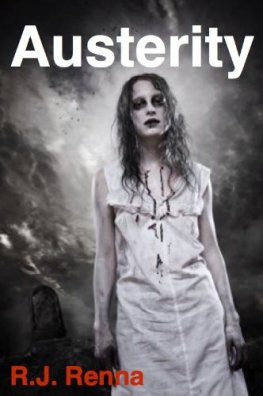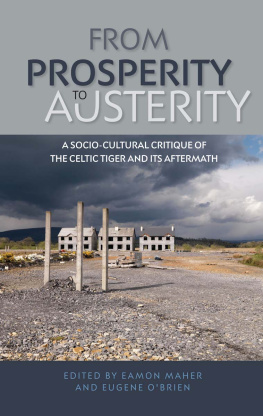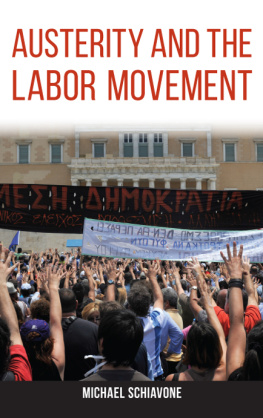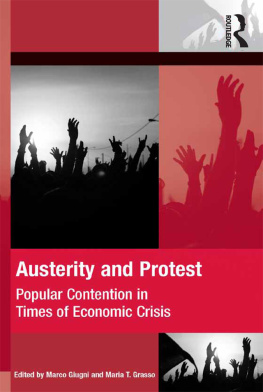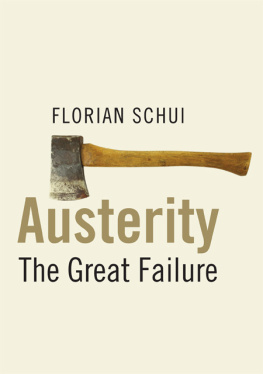
Popular Culture and the Austerity Myth
Contemporary popular culture is engaged in a rich and multi-levelled set of representational relations with austerity. This volume seeks to explore these relations, to ask: how does popular culture give expression to austerity; how are its effects conveyed; how do texts reproduce and expose its mythic qualities? It provides a reading of cultural texts in circulation in the present age of austerity. Through its central focuspopular cultureit considers the impact and influence of austerity across media and textual categories. The collection presents a theoretical deconstruction of popular cultures reproduction of, and response to, mythical expressions of austerity in Western culture, spanning the United Kingdom, North America, Europe and the Middle East and textual events from political media discourse, music, videogames, social media, film, television, journalism, folk art, food, protest movements, slow media and the practice of austerity in everyday life.
Pete Bennett is Senior Lecturer in Postcompulsory Education at University of Wolverhampton, UK.
Julian McDougall is Head of the Centre for Excellence in Media Practice and Professor in Media and Education at Bournemouth University, UK.
Routledge Research in Cultural and Media Studies
For a full list of titles in this series, please visit www.routledge.com
89 Postfeminist Celebrity and Motherhood
Brand Mom
Jorie Lagerwey
90 Technologies of Consumer Labor
A History of Self-Service
Michael Palm
91 Performing Ethnicity, Performing Gender
Transcultural Perspectives
Edited by Bettina Hofmann and Monika Mueller
92 Materiality and Popular Culture
The Popular Life of Things
Edited by Anna Malinowska and Karolina Lebek
93 Girlhood, Schools, and Media
Popular Discourses of the Achieving Girl
Michele Paule
94 The Creative Underground
Arts, Politics and Everyday Life
Paul Clements
95 Subjectivity across Media
Interdisciplinary and Transmedial Perspectives
Edited by Maike Sarah Reinerth and Jan-Nol Thon
96 The Rise of Transtexts
Challenges and Opportunities
Edited by Benjamin W.L. Derhy Kurtz and Mlanie Bourdaa
97 Explorations in Critical Studies of Advertising
Edited by James F. Hamilton, Robert Bodle, and Ezequiel Korin
98 Popular Culture and the Austerity Myth
Hard Times Today
Edited by Pete Bennett and Julian McDougall
First published 2017
by Routledge
711 Third Avenue, New York, NY 10017
and by Routledge
2 Park Square, Milton Park, Abingdon, Oxon OX14 4RN
Routledge is an imprint of the Taylor & Francis Group, an informa business
2017 Taylor & Francis
The right of the editors to be identified as the authors of the editorial material, and of the authors for their individual chapters, has been asserted in accordance with sections 77 and 78 of the Copyright, Designs and Patents Act 1988.
All rights reserved. No part of this book may be reprinted or reproduced or utilised in any form or by any electronic, mechanical, or other means, now known or hereafter invented, including photocopying and recording, or in any information storage or retrieval system, without permission in writing from the publishers.
Trademark notice: Product or corporate names may be trademarks or registered trademarks, and are used only for identification and explanation without intent to infringe.
Library of Congress Cataloging-in-Publication Data
CIP data has been applied for.
ISBN: 978-1-138-94294-3 (hbk)
ISBN: 978-1-315-67280-9 (ebk)
Typeset in Sabon
by codeMantra
Where are the red-eyed dreamers and clenched fist fighters?
Didnt they swear when these walls fell a citadel would rise?
Theyve turned to schemers, all, and underwriters
Leaning on the parapets to tell the same old lies.
Nick Burbridge, After the Deluge
Pete For Karon (one leg or two), Jack, Kate, Molly and Tom (who brings context to all things).
Julian for Alex, Lyd and Ned (keeping the faith) and RIP Tony Benn.
For various kinds of inspiration and support, the editors wish to thank the chapter authors, Helen Davies and Claire OCallaghan for the original idea and also Pete Wall, Jerry Slater, Pete Fraser, Nick Duncan, Mel Crawford, Libby Sprason and Justin Hateley.
Neil Badmington
Readers of the illustrated edition of Roland Barthess Mythologies published in France in 2010 might be forgiven for thinking that the book speaks solely to distant days. The images of the mid-twentieth century selected with such care by Jacqueline Guittard depict scenes which belong unmistakably to the past: the new Citron adorning the cover of Paris-Match in 1955; garish cookery filling the pages of Elle; anti-colonial protestors in the streets; Souzay at the microphone; a young, slender Marlon Brando examining fruit and vegetables at a market stall.
In illustrating so vividly the moment with which Barthess essays were engaged, in laying out with such visual verve the guises of the mystification which transforms petit-bourgeois culture into a universal nature (Barthes 2009, xvii), Guittards edition of Mythologies, for all its revelation and beauty, runs the risk of rendering Barthess project a temporally specific intervention. The colours, the fashions, the designs, the settings, even the typography all of these details leap out from the pages as lost time. The books commitment to History begins to look at once like a commitment to history.
Barthes himself went some way towards describing Mythologies as outmoded, in fact, when he wrote a rather weary preface for a reissue of the text in 1970, thirteen years after its first appearance in print. The work, he explained, has a double theoretical framework: on the one hand, an ideological critique bearing on the language of so-called mass-culture; on the other, a first attempt to analyse semiologically the mechanics of this language (Barthes 2009, xvii). He continued:
It is obvious that the two attitudes which determined the origin of the book could no longer today be maintained unchanged (this is why I have made no attempt to bring it up to date). Not because what brought them about has now disappeared, but because ideological criticism, at the very moment when the need for it was again made brutally evident (May 68), has become more sophisticated, or at least ought to do so. Moreover semiological analysis, initiated, at least as far as I am concerned, in the final essay of Mythologies, has developed, become more precise, complicated and differentiated: it has become the theoretical locus wherein a certain liberation of the significant, in our country and in the West, may well be enacted. I could not therefore write a new series of mythologies in the form presented here, which belongs to the past.


